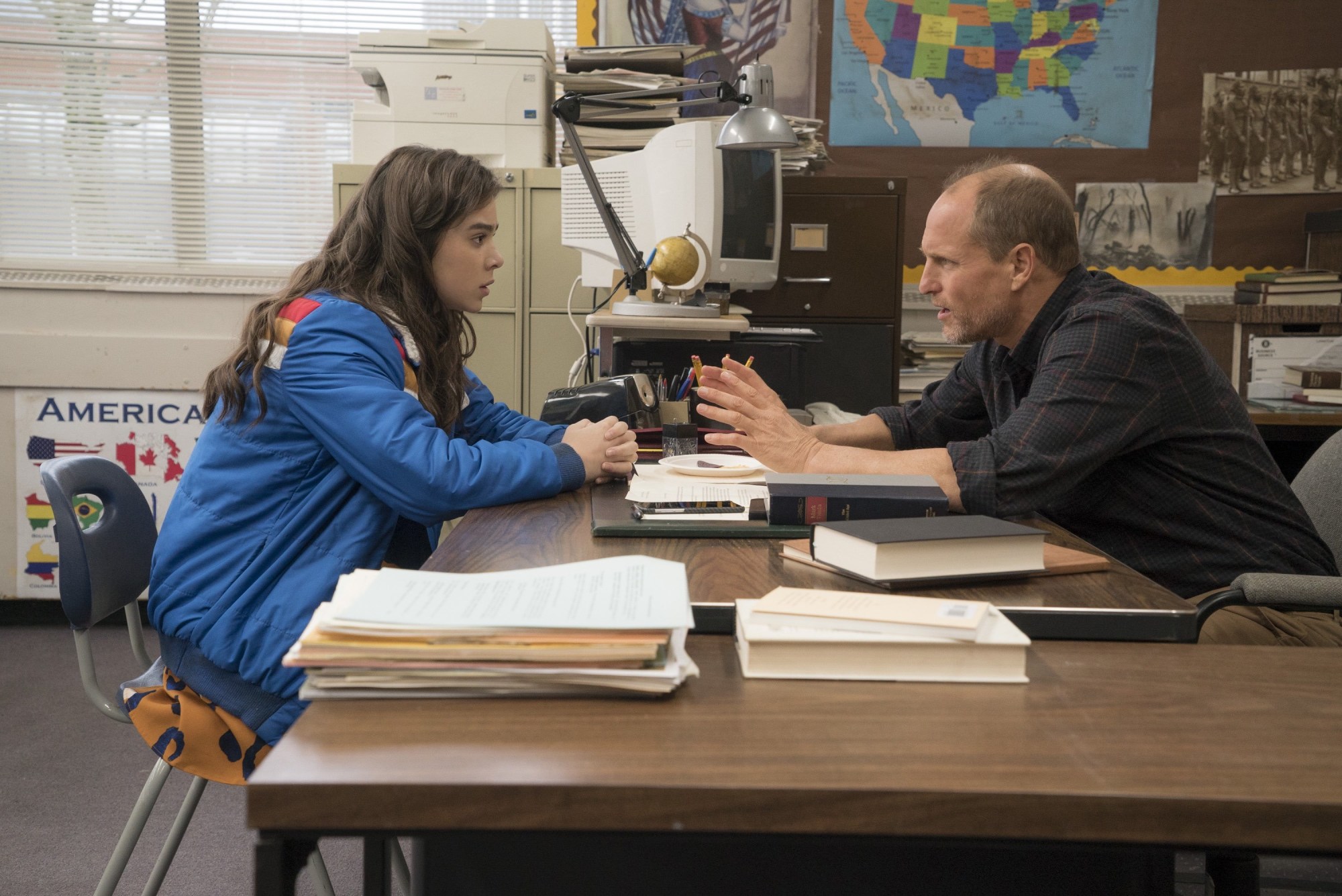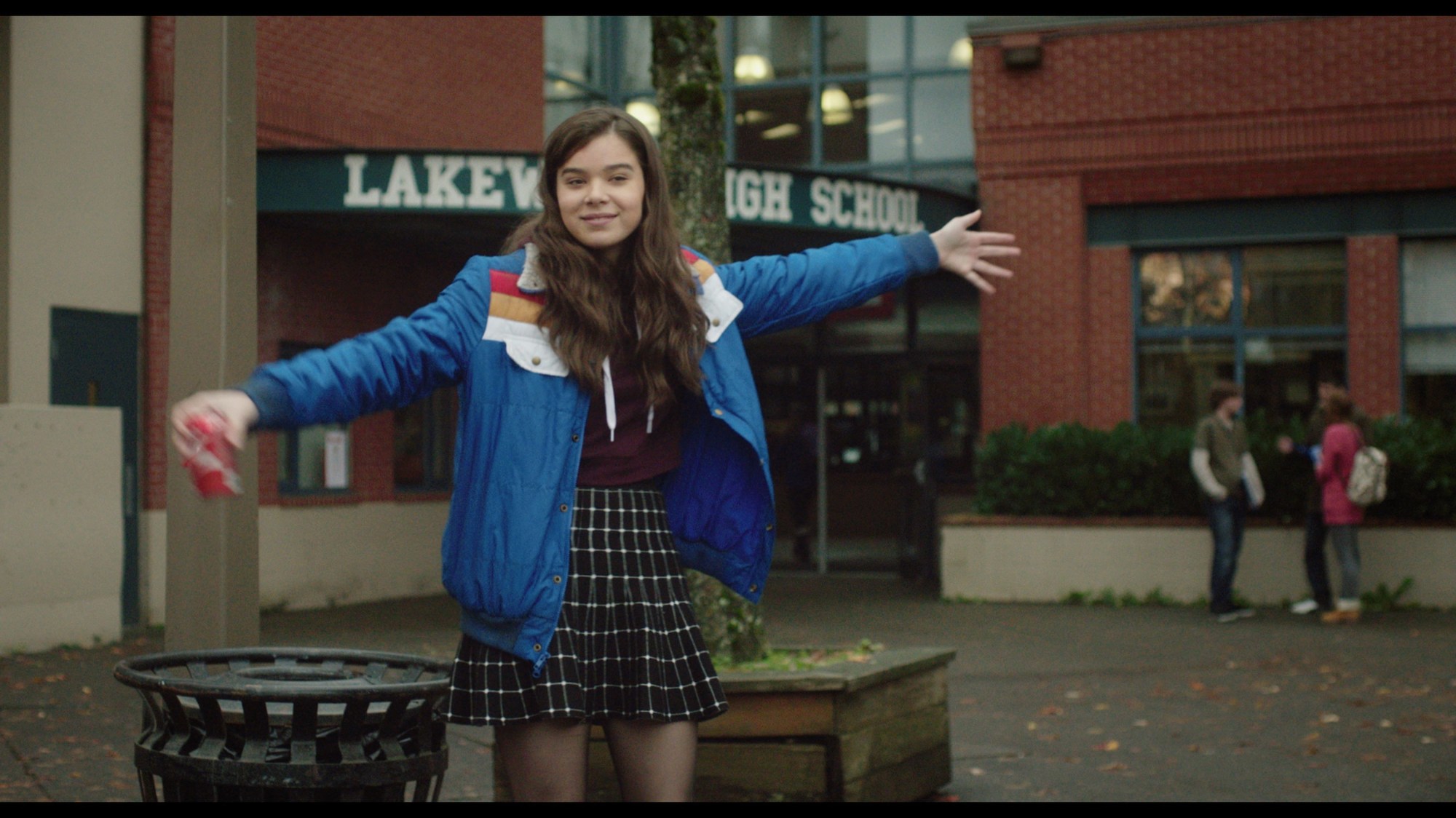Watching The Edge of Seventeen is like looking at pictures of yourself from when you were growing out your bangs, very into shoegaze, and totally ignorant of how to dress for your still-changing body shape. It makes you feel feelings of teenage despair so vividly that it would be a deeply uncomfortable experience if it weren’t also so funny.
Since it premiered at the Toronto Film Festival in September, the movie has drawn comparisons to Clueless, Sixteen Candles, and The Breakfast Club. Rolling Stone called it an “instant teen-movie classic.” It even boasts the same producer as Say Anything (the legendary James L. Brooks). But the film’s total aversion to aestheticizing coming of age puts it in another category. A category in which it sits almost alone — like the movie’s protagonist, Nadine, when she eats her sad lunchtime sandwich in the classroom of her favorite teacher and reluctant mentor (Woody Harrelson).
Nadine (played by Hailee Steinfeld) gets the kind of complex inner life and terrible wardrobe often only afforded to male characters in coming-of-age movies. The film follows her as she navigates high school and a snowballing sense of existential despair in suburban Portland. She wears off-brand hidden-platform sneakers, nondescript logoed hoodies, and an 80s puffer jacket that always manages to look old rather than vintage. The plot lines, too, are realistically unglamorous. Nadine loses her one friend when she hooks up with Nadine’s older brother (meanwhile Nadine is passed out on the bathroom floor upstairs after going on a sleepover liquor bender). Nadine develops a new friendship with a sweet Korean boy who draws cartoon aliens in his spare time and has an unrequited crush on her. Nadine writes a graphic Facebook message to her crush, a boy with an emo haircut that she mistakes for hidden emotional depths, about how she wants to have sex with him in the stockroom of a Petland. She accidentally sends it.
As the movie hits theater today, we speak with the movie’s newcomer writer and director, Kelly Fremon Craig, about documenting “the ugly parts” of being 17.
What was the starting point for the script? Did you have a clear idea of the story you wanted to tell?
There were a couple of life things I wanted to explore. It’s always fascinating to me when your comforts are torn away and you’re left having to deal with yourself. So that was interesting to me. Also, I really wanted to explore how at that age it’s really easy to feel like you’re the only one who’s a mess while everyone else if faring much better with life — how scary and lonely and painful it is to feel like you’re the only one who’s having a hard time. I wanted to explore what it feels like to be that age, and be a mess, and be a lot of different things at once. To say, “Here it all is, even the ugly parts.”
Did you look back at your own life to tap into those feelings?
I remember very vividly having those feelings at that age, and to a large extent I still experience some of the things that Nadine experiences in this film. Maybe the only difference is that now, with more experience, I understand that they’re not permanent. When things are tough I know it’s not the end of the world, that this too shall pass. Whereas at that age you really just think you’re going to be in hell forever. But in general, I think that I’ve been guilty of what she’s guilty of, which is not being able to see past your own pain. Not being able to get out from under it.
Right at the end of the movie, Nadine has a moment of clarity in which she acknowledges her frustration about the way she’s acted. That made me hopeful she’d be ok.
I think there’s some power just in naming that, just in saying, “I think I’m doing this and I don’t know how to change it and I might never change,” but naming it seems like a first step towards something healthier.
One of my favorite aspects of the movie was how accurate all the little details were — the characters wear ill-conceived outfits and listen to top 40 music.
Yes! I definitely went a little nuts over the costumes. [Creating] a reality, and making things feeling sort of worn down by life and put through the wash too many times was important to me. Getting Nadine’s look and costume right was a real feat, and hours and hours of trying on different things.
I liked that she even looked like she was growing out some childhood bangs.
God, yes! When they’re just that awkward length!
How did you make sure all those details felt true to life?
I did a really intensive period of research for about six months. I spent that time interviewing teenagers and hanging out at high schools, being a fly on the wall, observing and soaking it in. I really think nothing gives you a sense of mission like speaking to people who have gone through whatever story you’re trying to tell. You see faces when you’re writing. You just feel a commitment to getting their stories right.
There aren’t many coming of age stories about women that do get it right, perhaps because there are so few that were actually directed by women. Did thinking about that make you feel any extra sense of responsibility?To be honest, I really tried to force that out of my mind. When I think about it in those terms, it feels daunting! Terrifying. The master for me, the thing I was serving every day all day, was trying to accomplish a sense of authenticity. Just every day saying, “Is it real? Is it real? Are we really being as honest as we can? What’s the truth?” That was always at the center of it.

How much did you adapt the script during filming to make sure everything felt authentic?
I wrote this as a spec script and it was one version, then I did this six months of research and I came back from it and said to Jim [Brooks], “I have to throw everything away and start over.” When I did start over, not a single line from the original script remained. At that point, I felt I was really getting it right, or at least getting down the reality as I had experienced it through the interviews and research.
When you spoke with teenagers at high schools, how similar or different were their experiences to your own?
It felt shockingly similar. I went in thinking I was to going to be searching for differences but found that instead that I was constantly confronted by things I felt at that age and still feel, to a degree. No matter who I talked to — whether they were a kid at the top of the social food chain, or at the bottom — everybody was dealing with the same things. Everybody, on some level, was trying to figure out who they are, and desperately wanting to connect with other people, to be seen truly for their full self. I think part of that too is because of social media, and all of us putting these edited versions of ourselves out there for everyone else to consume. I think that’s driving us further apart. It’s causing everyone to feel a little lonelier. There’s just more to dig through to get to the truth of who someone is. And it’s easier to romanticize people’s live than ever, now that we can have this constant scroll of vacation pictures. I mean, I still do that with people!
James L. Brooks, who produced the film, also produced teen classic Say Anything, as well as of course The Simpsons. How did he become involved?When I first wrote the spec script, my team and I sat down and said, “All right, where do we send it?” And Jim Brooks has always been the person I admire more than anybody else in the world. I have loved his work from the deepest parts of me my whole life. So he was the first person on the list. It was a giant Hail Mary pass! But he took on the project. It still feels surreal.
Do you know yet what your next project will be?
This movie has opened up a lot of cool opportunities. I’m just sorting through those and trying to find the thing that I can care obsessively and neurotically about! Doing this, I realized that I’ve got to really, really want to feel, “Oh man, this I really understand on, like, a biological level. I feel this thing in my soul, and I’ve got to say it!” So I’m looking for that for my next project! We’ll see.
“The Edge of Seventeen” is in theaters now.
Credits
Text Alice Newell-Hanson
Photography Murray Close courtesy STX
